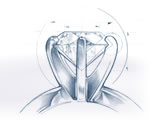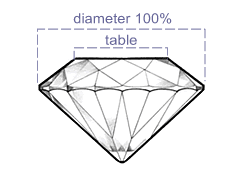


 |
 |
 |
| Become a diamond expert with our Diamond Education, or go to a specific subject: |
| Learn in detail about Diamond Cut. |
Diamond Table and its Importance |
 The table is the flat facet at the upper most part of the diamond. The face of the diamond it is on of the most essential part of the diamond cut. The table has a great influence on the brilliance and fire of the stone. Brilliance or sparkle is the outcome of the interplay and refraction of light from the stone. Fire means the variation in brilliance and color noticed when the light is refracted back. These most essential features are determined by the accurate size of the table. If the table is too big, the diamond will lose its fire, but will have a breathtaking brilliance. On the other hand if the table is too small, the diamond will lose its brilliance though displaying optimum fire. The cut of the diamond is also the deciding factor of the table size. An experienced diamond cutter would generally make a larger table. The table is the flat facet at the upper most part of the diamond. The face of the diamond it is on of the most essential part of the diamond cut. The table has a great influence on the brilliance and fire of the stone. Brilliance or sparkle is the outcome of the interplay and refraction of light from the stone. Fire means the variation in brilliance and color noticed when the light is refracted back. These most essential features are determined by the accurate size of the table. If the table is too big, the diamond will lose its fire, but will have a breathtaking brilliance. On the other hand if the table is too small, the diamond will lose its brilliance though displaying optimum fire. The cut of the diamond is also the deciding factor of the table size. An experienced diamond cutter would generally make a larger table.Understanding diamond table helps one understand brilliance and fire of a diamond. The knowledge also helps one understand why a good number of elongated and oddly shaped stones are much cheaper, even though their carats are higher. |
History of Table |
Did you know, in earlier centuries the diamond did not have any table? Strange but imagine a diamond with a pointed surface as it looked until the middle of 14th century. In fact till the 11th century diamond was used in its uncut form in jewelry. However with the introduction of the polishing wheel the face of the diamond literally began to change. As diamond cutters began to experiment, table cut became the first major faceted diamond cut. The previously pointed tip was cut to get a flat table like facet though much importance was still not given to fire and brilliance. The changing times lead to the evolution of different cuts as brilliance too started getting its due importance. Today table is an important-inseparable aspect of a diamond as people are more aware about its importance. Diamond lovers want both brilliance and fire so the demand for ideal cut diamond has gone up. |
How is the Table Proportion Calculated? |
||||||||
Table percentage is derived by comparing the maximum table width with the total width of the diamond. In order to derive the table percentage of a round diamond, the largest diameter is used whereas for other fancy cuts smallest diameters can be used. For a round brilliant cut diamond, table percentage is calculated as follows: Ideal Table Proportions of Different Round Diamonds
|